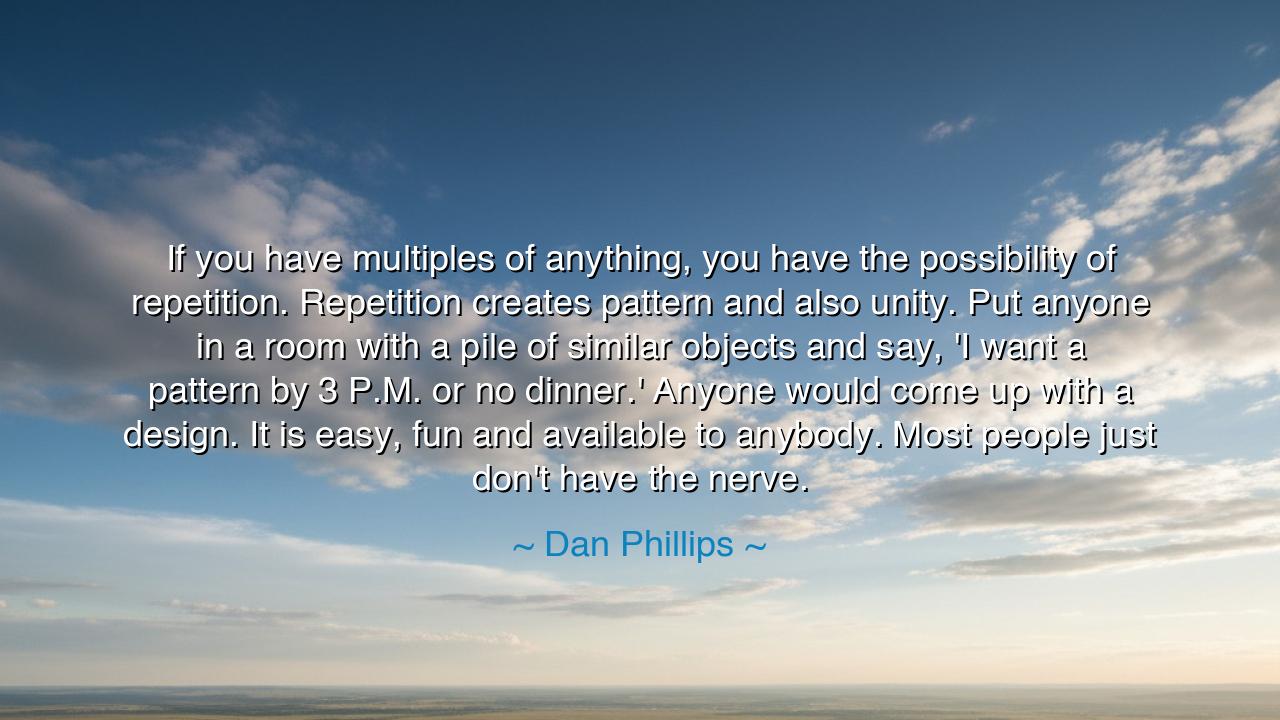
If you have multiples of anything, you have the possibility of
If you have multiples of anything, you have the possibility of repetition. Repetition creates pattern and also unity. Put anyone in a room with a pile of similar objects and say, 'I want a pattern by 3 P.M. or no dinner.' Anyone would come up with a design. It is easy, fun and available to anybody. Most people just don't have the nerve.






Dan Phillips, the humble builder and philosopher of reclaimed beauty, once said: “If you have multiples of anything, you have the possibility of repetition. Repetition creates pattern and also unity. Put anyone in a room with a pile of similar objects and say, 'I want a pattern by 3 P.M. or no dinner.' Anyone would come up with a design. It is easy, fun and available to anybody. Most people just don't have the nerve.” Beneath his playful words lies a wisdom both ancient and eternal — a lesson not only about design, but about creation, courage, and the divine order that flows through all things. Phillips speaks not merely of architecture or art, but of life itself — of how patterns emerge from chaos, how unity is born from repetition, and how creativity belongs to all who dare to act.
The meaning of this quote rests in its revelation that creation is not the privilege of the gifted few, but the birthright of every human soul. To create pattern is to bring order from disorder — to take the raw material of existence, however humble, and give it meaning. When Phillips speaks of “multiples of anything,” he is not merely referring to bricks or tiles or sticks, but to the countless repetitions that form the rhythm of life: footsteps, heartbeats, sunrises, and mistakes. Each repetition, when embraced consciously, becomes design — a structure through which beauty and meaning emerge. Yet, he reminds us, the secret to creation lies not in talent, but in nerve — the courage to begin, to experiment, and to trust the instinct that whispers: You can make something of this.
The origin of this insight springs from Phillips’ own work as a visionary builder. Known for creating homes entirely from salvaged materials — shards of tile, bottle caps, mismatched wood, even bones and mirrors — he discovered that what others saw as junk could become art through repetition. His houses, whimsical yet harmonious, reveal the universal truth that beauty does not depend on perfection, but on pattern and persistence. When fragments are arranged with care and consistency, they transform — as broken tiles become mosaics and discarded bottles become windows of light. From this, Phillips learned that creativity is not about wealth or tools, but about seeing the potential for order where others see waste.
History, too, testifies to this truth. Consider the ancient Romans, who laid countless stones to build their roads — each one small, each one ordinary, yet together forming paths that endured for millennia. Or think of the weavers of Egypt, whose repeated threads birthed tapestries that told stories of gods and kings. Even in music, repetition is the mother of harmony — it is the recurring beat that gives melody its strength. What Phillips teaches is what humanity has always known but often forgets: that unity arises from repetition, and repetition is the humble miracle that turns chaos into form.
But why, then, do “most people just not have the nerve”? Because creation demands vulnerability. To arrange, to experiment, to make something from nothing is to risk failure, and in that risk lies fear. People wait for permission, or for inspiration, when all they truly need is the courage to begin. Phillips, in his humor, strips away the illusion of genius. He reminds us that design is instinctive, that pattern-making is written into the human spirit. Give a child pebbles, and they will make circles; give a laborer bricks, and he will make walls. The divine impulse to create lies dormant only until courage awakens it.
And yet, there is a deeper layer still. Phillips’ reflection on pattern and unity is also a mirror of how we live. Our habits — our repeated actions and thoughts — are the bricks of our existence. Just as a builder creates with his materials, so do we craft our lives with our choices. If we repeat kindness, we create harmony. If we repeat fear, we create disorder. Every day, we stand in a room filled with the “multiples” of our thoughts and actions, and we are called, as he says, to design — to shape them into a life that reflects who we wish to be. To do so is both art and responsibility, for the patterns we make ripple beyond us, forming the architecture of our world.
The lesson is as timeless as it is practical: creation begins with courage. You do not need wealth, talent, or divine inspiration — only the willingness to start. Gather what you have — your fragments, your repetitions, your flaws — and shape them into something meaningful. Whether you build a home, write a poem, or live a life of purpose, remember that beauty is born not from rarity, but from rhythm. Repetition is the heartbeat of creation, and unity is its song.
So, my children of the maker’s spirit, remember this: in your hands lies the power to design. Stand in the room of your own life, surrounded by the materials of your days, and dare to begin. Do not wait for perfection; find the pattern in what you already possess. For as Dan Phillips reminds us, creation is not the privilege of a few — it is “easy, fun, and available to anybody.” The only question is whether you have the nerve to build beauty from the ordinary, and in doing so, to leave behind a world more harmonious than the one you found.






AAdministratorAdministrator
Welcome, honored guests. Please leave a comment, we will respond soon